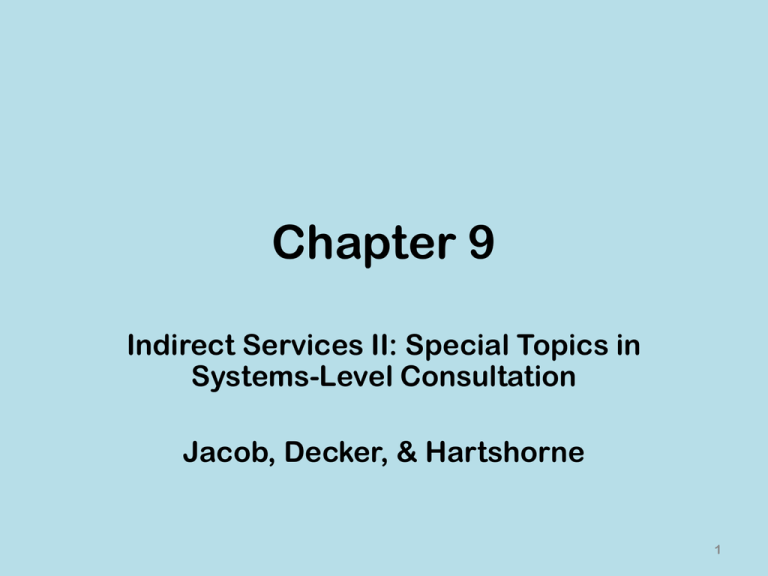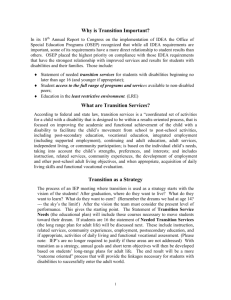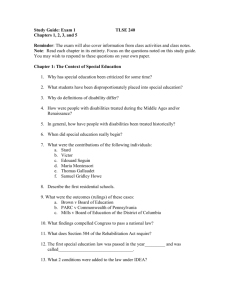Chapter 9
advertisement

Chapter 9 Indirect Services II: Special Topics in Systems-Level Consultation Jacob, Decker, & Hartshorne 1 Systems-Level Consultation Systems-level consultation refers to cooperative problem solving between the school psychologist (consultant) and consultee(s) (e.g., principal, district-level administrators) with the goal of improving school policies, practices, and/or programs so as to better serve the mental health and educational needs of all students. 2 NASP’s Code of Ethics “School psychologists use their professional expertise to promote changes in schools and community service systems that will benefit children and other clients. They advocate for school policies and practices that are in the best interests of children and that respect and protect the legal rights of students and parents” (NASP-PPE IV.1.2). 3 Student Proficiency Assessment Programs A heightened emphasis on school accountability gave impetus to the development of statewide student performance assessment programs. • The No Child Left Behind Act of 2001 requires each state to develop challenging academic content standards for mathematics, reading or language arts, and science and measurable achievement standards for those content areas. • IDEA requires children with disabilities to participate in statewide student proficiency assessment programs. Students with disabilities may take their state-wide assessment with or without individualized testing accommodations, and/or with modified proficiency standards, or they may take an alternative assessment specifically designed to document progress in relation to the student’s Individualized Education Program (IEP) objectives. 4 Student Proficiency Assessment Programs • • • • School psychologists can play a positive role in improving school test performance by: assisting districts in evaluating the consistency among their goals, curriculum, and the test demands; promoting quality evidence-based instructional practices; providing consultation to improve student testtaking skills; and identifying appropriate test accommodations for students with disabilities. 5 Minimum Competency Testing • Minimum competency testing is the practice of requiring a student to achieve a certain score on a standardized test in order to be promoted or to receive a high school diploma (vs. certificate of attendance). • Debra v. Turlington (1984) was a key case. 6 Minimum Competency Testing • • • • A state may require students to pass a competency test to receive a diploma if: There is adequate notice, namely a phase-in period before the test is used to determine the award of a diploma. The test has adequate curricular validity, namely the curriculum of the school matches what is measured by the test. There is documentation of adequate instructional validity, that is, the students are taught what is outlined in the curriculum. Note that students with disabilities also may be required to pass a competency test to receive a high school diploma. 7 School Entry and Grade Retention • When a child is age-eligible to attend public school, a school district must offer him or her an education at district expense. • Grade retention appears to have no lasting beneficial effect. The courts have preferred not to interfere with grade retention decisions. 8 Instructional Grouping • Assignment of students to self-contained classes based on ability does not improve the achievement of low-ability students. • Within-class instructional grouping is legally permissible. • Disproportionate representation of ethically and linguistically diverse students in special education is a complex problem and addressed in IDEA. 9 School Discipline • Schools have been given much discretion by the courts to fulfill their duty to maintain discipline. • The reasonable use of corporal punishment is not unconstitutional and is permitted in many states. • School principals may suspend students for 10 days or less as long as notice and the opportunity to be heard are provided. Expulsion requires more formal due process and usually requires action by school board. 10 Discipline of Students with Disabilities • Students with disabilities have greater protections with regard to disciplinary removals. • The portions of IDEA that address disciplinary removals are complex. • A manifestation determination review is conducted to determine whether a child’s disciplinary infraction was caused by his or her disability and/or the school’s failure to implement the child’s IEP. 11 Discipline of Students with Disabilities • In general, when the misconduct is a manifestation of a disability or the school’s failure to implement the child’s IEP, the school is required to conduct a functional behavioral assessment and implement or revise the child’s IEP. • In general, when misconduct is not a manifestation of a disability or the school’s failure to implement the child’s IEP, the school is required to conduct a functional behavioral assessment and implement or revise the child’s IEP, but the child may be placed in a different setting (e.g., suspension). The child with a disability under IDEA must continue to receive special education. Schools may discontinue services to a 504-only students as long as nondisabled students receive the same treatment. 12 School Violence Prevention • NASP’s code of ethics encourages school psychologists “to use their expertise in psychology and education to promote school, family, and community environments that are safe and healthy for children” (IV.1). • Researchers have identified a number of modifiable school factors that may be protective against student self-harm or violence towards others. School-wide programs that emphasize positive behavioral supports likely contribute to enhanced school safety and student mental health. • All school districts should have a comprehensive safe school plan that addresses violence prevention, intervention, and response. 13 School-Wide Efforts to Screen and Identify Students “At Risk” for Targeted Violence • Inappropriate labeling and stigmatization? • Invasion of pupil and family privacy without consent? • Misuse of results? 14 HARASSMENT AND DISCRIMINATION “In their words and actions, school psychologists promote fairness and justice. They use their expertise to cultivate school climates that are safe and welcoming to all persons regardless of actual or perceived characteristics including race, ethnicity, color, religion, ancestry, national origin, immigration status, socioeconomic status, primary language, gender, sexual orientation, gender identity, gender expression, disability, or any other distinguishing characteristics”(NASPPPE I.3). 15 Fostering A School Climate Free from Discrimination and Harassment • NASP’s 2010 code creates a clearer ethical obligation to help foster a school climate that is free from discrimination and harassment • Recent years have witnessed an increase in lawsuits resulting from student-on-student harassment 16 Key Cases Davis v. Monroe Country Board of Education (1999) Davison v. Santa Barbara High School (1998) Nabozny v. Podlesny (1996) and its progeny Also see Weber (2002) “Disability Harassment in the Public Schools” law review article. 17 Improving the Climate of Schools • Student-on-student harassment may be a precursor to even more serious acts of sexual assault or physical violence. • Through advocacy and education of staff and students, practitioners work to foster a school climate that promotes not only understanding and acceptance of, but also a respect for and valuing of individual differences. 18





